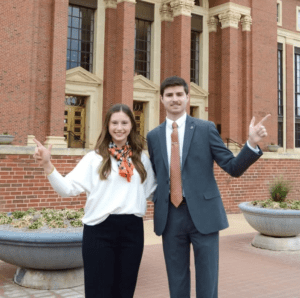Editor’s Note: This article was written and researched by Jim Craig of the Association of Graveyard Rabbits and Genabloggers.
If you drive the tree-lined roads of Memorial Park Cemetery in suburban Chicagoland, you may happen upon an impressive monument by the side of the road. It is the burial site of William Collin (“Billy”) Levere, who was intimately associated with the Sigma Alpha Epsilon fraternity at Evanston’s Northwestern University. This name may ring a bell because there is an impressive gothic church-like structure on Sheridan Road in Evanston called the “Levere Memorial Temple.” Let’s see what we can find out about this man to deserve such an impressive burial site, and a temple named after him.
William Collin Levere was born on October 10th, 1867, in New Haven, Connecticut, to Charles Frederick Levere (1842-1910) and Mary, nee Collins (1844-1881). Charles and Mary had been married in New Haven on November 1st, 1866. They had one other son in addition to Billy: Frederick Edwin Levere (1874-1960). There are some sources that list another brother, John Levere, but I was not able to find any evidence of him. Charles Levere was a harness maker by trade.
While researching this article, I stumbled across an interesting inconsistency. Most every source lists William Levere’s date of birth as October 10th, 1872; however, he shows up on the 1870 US Census for New Haven, Connecticut. According to the census, he was two years old on July 2nd, 1870. That would make his actual date of birth on October 10th, 1867. He correctly reported his month and year of birth as October 1867 for the 1900 Census, but for the 1910 Census, he said he was 27 when he was 32. From that point on, he consistently reported his date of birth as October 10th, 1872 – including when he applied for a US Passport in 1917.
In grade school, young Billy Levere cultivated a talent for public speaking. He won several oratory contests and toured New England, where he was asked to speak on a wide variety of topics with temperance being his favorite topic.
When Levere was fourteen years old, his life changed forever after meeting the “First Lady of Temperance” Francis Willard. She suggested that he move to Evanston, Illinois, which was her adopted home town. Levere’s mother had died in September of 1881, so perhaps he thought it was time for a change. Francis Willard helped Billy Levere gain admittance to Northwestern Academy, where he attended high school, and later Northwestern University. During this time, Levere continued to lecture on the national temperance circuit and took odd jobs to pay for his school tuition and room and board.
Interestingly, at first, Billy Levere didn’t have much use for fraternities. He was the leader of the anti-fraternity movement at Northwestern. However, Sigma Alpha Epsilon had established a chapter at Northwestern during the fall of his freshman year, and they actively recruited Levere because of his obvious leadership potential. Levere was hand-picked by SAE expansionist Harry Bunting who first recruited Levere’s roommate and best friend and then pursued Billy directly. On September 26th, 1894, Levere was initiated as a charter member of the new Psi-Omega chapter, where he quickly became a chapter leader.
Levere eventually left Northwestern to join the temperance lecture circuit full time. He was increasingly interested in politics and his literary career. He was elected Magistrate of the Evanston City Court while still a student at Northwestern in 1897. Levere ran on the Republican ticket that was headed by another subject of this blog, Mayor William A. Dyche. William Levere ran unsuccessfully for Evanston City Treasurer in 1899 but was finally elected to that post in 1901.
The 1900 US Census has William C. Levere living at 1577 Sherman Avenue in Evanston. The former Chandlers Building occupies that site today. He correctly reported (for the last time) that he had been born in October of 1867. He reported his occupation as “Justice of the Peace.”
Levere served as Evanston City Treasurer from 1901-1903. During this period, he also pursued his passion for writing. He was a reporter for the Chicago Evening Post and served as editor of the Evanston Index from 1901-1905. He also edited the “Greek Quarterly,” was a founder of the College Fraternity Reference Bureau, and was editor of SAE periodicals “The Record,” and “Phi Alpha.”
In 1906 William Levere decided to expand his political career beyond the borders of Evanston. He ran for and was elected Illinois State Representative. Springfield didn’t suit him, however, and he declined to run for a second term.
Levere’s love for Sigma Alpha Epsilon began to consume increasing amounts of his time. From 1902-1906 he served as Eminent Supreme Archon, the highest elected position in the Fraternity. He was elected Honorary Eminent Supreme Archon from 1909-1910 and also saw to financial affairs for a time as Eminent Supreme Treasurer.
The 1910 US Census has William C. Levere living at 600 Davis Street in Evanston. He gave his age as thirty-seven; he was forty-two. He listed his occupation as “Writer of History.”
William Levere attempted to enlist in the military when the US became involved in World War I in 1917. Admitting to being 44 (he was 49) and being almost 250 pounds, his application was rejected. After his rejection by the military, he turned to non-governmental entities, thinking that their requirements would not be as strict. So Levere was surprised when his application to the Red Cross was rejected. As a last resort, he applied to the Young Men’s Christian Association (YMCA) and, to his delight, was accepted. Billy Levere had found his niche with the YMCA. He operated a canteen in France and served the American “doughboys” in much the same way he provided care and comfort to collegiate fraternity members across the country. His involvement with the YMCA was so significant that Katherine Mayo dedicated an entire chapter to Levere in her 1920 book on the YMCA in World War I entitled That Damn Y.
When the war ended in November of 1918, Billy Levere returned to Evanston, where he threw himself into fraternity work even more than before. For years, Levere’s apartments in Evanston had served as the national headquarters of Sigma Alpha Epsilon. When he came home, he was more convinced than ever that SAE needed an official national headquarters building. He also wanted it to serve as a national memorial for SAEs, who died in the Great War. At SAE’s 1920 convention, he was able to put his plan into action. The convention voted to centralize the government and offices of SAE, fund the construction of a “Central Office Building,” and create a fundraising program to cover the costs.
The 1920 US Census finds William Levere living at 703 Davis Street in Evanston. This is around the corner from where he lived in 1900 – space occupied by the former Chandler’s building today. He listed his occupation as “Literary Work.”
With the centralization of the Fraternity underway, Levere began to pursue his dream of an office building. From the start, his plans included a library and a museum. In 1923 SAE purchased an old home on Sheridan Road in Evanston. The Fraternity finally had its office building and in the process became the first national fraternity to have a national headquarters building. But Levere was already dreaming of the grand structure that would one day replace the existing office. Levere then declared that he would begin to collect for SAE’s Library in earnest. It turns out that Levere, as a passionate collector, had started gathering material for years. By the end of 1924, he had amassed a vast library of works written by SAEs. It was reputed to be the second-largest fraternity collection, behind the William Raymond Baird collection at the New York Public Library.
In December 1926, Levere revealed the preliminary sketches of the Memorial Building that would replace the current office. He asked a fellow S.A.E., architect Arthur Knox, to submit designs for the structure. The modest initial plans were revised to increase the size of the library, and include a museum, memorial chapel, lecture hall, dining hall, residence space, dormitory, and office space. Levere’s new memorial building took its first steps to complete that same month when the national convention voted to construct the building and created a non-profit corporation that would own the building and collect donations for construction and maintenance.
Levere’s passion for his work, unwillingness to delegate tasks, and lack of recognizing his limits finally caught up with him. In January of 1927, he was admitted to Saint Francis Hospital in Evanston with a nervous breakdown, from which he never recovered. William Levere died on February 22nd, 1927. His wake was held at the SAE headquarters on Sheridan Road in Evanston.
We can’t say goodbye to Billy Levere without discussing the Levere Memorial Temple. As stated above, it was Levere’s goal in the mid-1920s to collect the funds to enable the Sigma Alpha Epsilon fraternity to construct a memorial building in honor of the SAE boys who died in World War I. After his sudden death in February of 1927, SAE found that Levere had left $25,000 for a new building. This, coupled with the fact that Levere had spent his life dedicated to the fraternity, prompted the decision to name the Memorial Building after him. So the Levere Memorial Temple was born.
William Collin Levere, who probably did more to advance the college fraternity system than any other man who ever lived, fondly remembered today by his brothers and fellow Evanstonians – may he rest in peace.










 Every $1,
Every $1,



